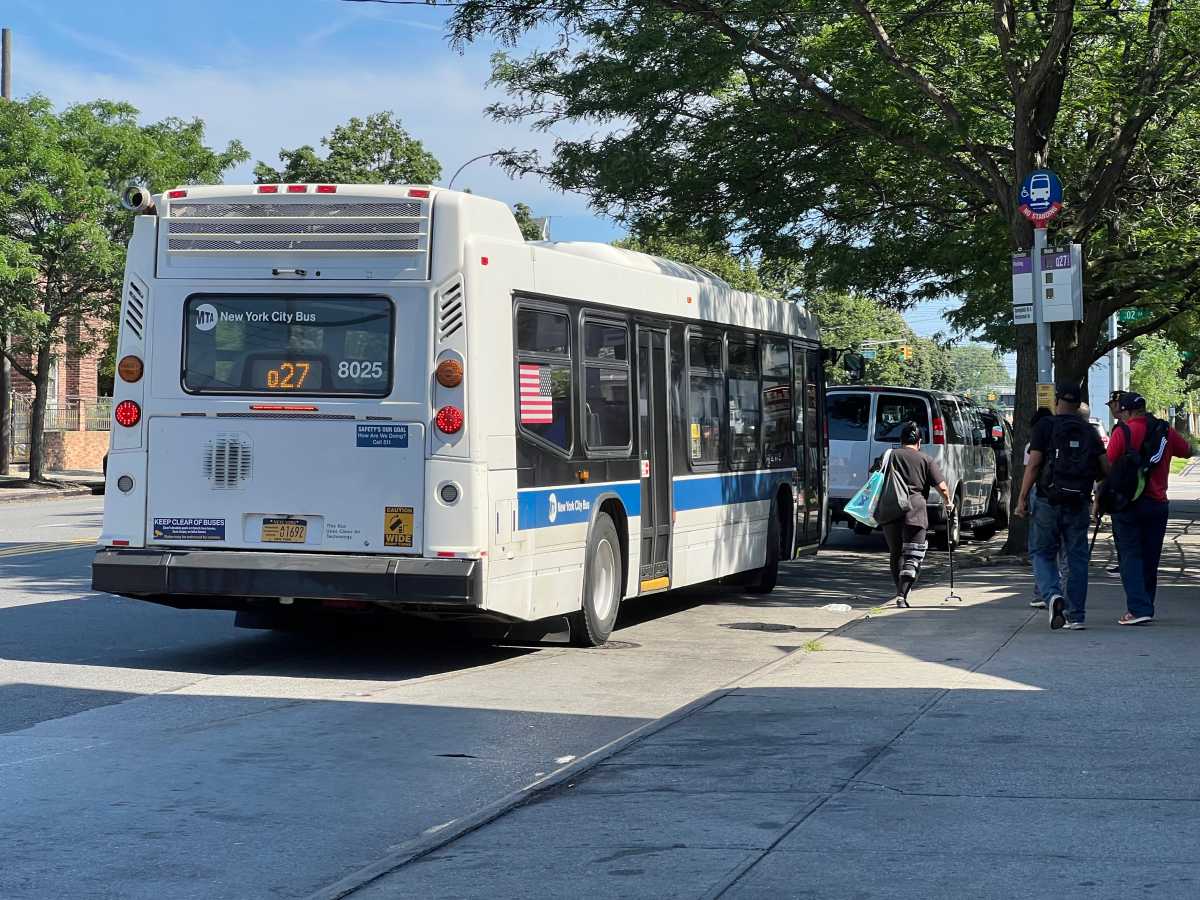Who would Jesus evict?
To the Editor:
Re “O.W.S. protesters convicted of trespassing vow to appeal” (news article, June 27):
It is disappointing, but not surprising, to read that Trinity Church chose to prosecute Occupy Wall Street activists — with one protester, Mark Adams, being sentenced to 45 days at Rikers — for “trespassing” on a vacant lot that Trinity got for free and is not currently using.
Episcopal Bishop George Packard, who was the first to scale the fence and was arrested on the preposterous charge of “trespassing” on his own denomination’s property, got it right when he addressed the court, saying, “Is [Trinity] a corporation worried about fiduciary interest or a portion of the Body of Christ?”
Let’s reflect on the bishop’s homily for a moment. Jesus taught us that “it is easier for a camel to pass through the eye of a needle than a rich man to enter the Kingdom of Heaven,” as well as, “Blessed are the meek, for they shall possess the land.”
Well, it seems that they don’t preach that part of the Gospel at Trinity. In fact, here we have a real estate enterprise cynically named after one of the most profound Mysteries of Christianity — the Trinity — behaving more like the Sadducees than like Jesus.
Further, in the early part of the 20th century, Trinity cruelly evicted thousands of impoverished tenants living in its residential properties on the Lower West Side in order to pave way for the many commercial buildings that are there now — the basis of Trinity’s enormous wealth.
At one time, Trinity provided several houses of charity Downtown to provide aid to the poor, the downtrodden, the oppressed. Now, it has none.
Trinity gives back only a fraction of the tens of millions in profits that it earns annually from its vast real estate holdings in Lower Manhattan to charity, and most of that goes to projects affiliated with Trinity.
Has Trinity never heard of the word “tithe” or “sharing the wealth”? I guess they believe that charity begins at home.
Trinity has now shown its true colors with its dispossession of the Occupy Wall Street folk, who are fighting for social and economic justice, for the “crime” of occupying a vacant lot that Trinity got for free.
We wonder where Jesus will be this Sunday: in the front pew of Trinity or in the Rikers Island jail cell with Mark Adams?
Sean Sweeney,
Director of Soho Alliance
We need more home play!
To the Editor:
Re “Millennium High gets funding for phys ed, but soccer team still struggles” (news article, June 27):
As a former high school teacher and college varsity volleyball player back in the day, I sympathize with the Millennium soccer “club” efforts to gain accreditation from the NYC Public Schools Athletic League by securing a home field. The P.S.A.L. should show more flexibility. What’s more outrageous, though, is that Millennium and other neighborhood schools don’t even have a “home court” for basketball, New York’s iconic sport.
Out in the cold are many high school students with varsity interest who are willing to put in strenuous after-school hours for a semester while trying to maintain their grades. This issue has been only partially addressed by way of small donations from local nonprofit youth programs, such as Urban Dove, that are earmarked for the rental of private gyms as “home courts” and then gifted to schools lacking these resources.
Our Downtown students deserve a more dependable solution than the kindness of strangers.
I know what the varsity team experience gave me. My intramural varsity play introduced me not just to teammates from many different ethnicities and backgrounds, but to players from other schools who differed from us.
It was a real eye opener. Rehashing games — not just plays, but players — demanded serious thought and the exchange of opinions on visceral topics. It was galvanizing and had a lifelong influence on my collegial activities. Varsity sports foster discipline, respect for knowledge-giving by coaches and teammates and the importance of being a team player.
Yet most of our underserved high schoolers don’t have the opportunity to experience these invaluable gifts of varsity play.
No public city high school should be without home courts and fields. I urge anyone who reads this letter to put this issue on their activist agenda.
Joan Young Gregg
Park Row resident
Don’t tempt Mother Nature
To the Editor:
Re “Saving pier and park” (editorial, June 21):
This editorial expresses the belief that, to address Hudson River Park’s financial problems, we all have to accept residential development on Pier 40. While we all share the same concern about the Pier 40 playing fields and the park’s financial stability, pinning our hopes on an environmentally inappropriate and increasingly risky, huge construction plan is a poor choice.
Two different reports were published in recent weeks that should give us pause. First, there was the report by Joe Lhota, chairperson and chief executive officer of the Metropolitan Transportation Authority, publicized by WNYC, that the walls of the renovated South Ferry subway station are leaking. Lhota attributed the problem to poorly sealed walls and “a rising water table.”
The second report, issued by the U.S. Geological Survey on June 25, indicated that the East Coast from Boston to North Carolina was a “hot spot” for climbing sea levels from global warming.
Water-level increases are also happening at a faster pace. Oceanographer Asbury Sallenger Jr. said, “Where that kind of thing becomes important is during a storm.”
Margaret Davidson, the director of the National Oceanic and Atmospheric Administration’s Coastal Services Center, stated in the same report that the implications of this new research are “huge when you think about it. Somewhere between Maryland and Massachusetts, you’ve got bodaciously expensive property at risk.”
Building along the Hudson River always has been a bad idea, but now it is even more environmentally and financially dangerous. Not only has little consideration been given to the inevitable downtime when the playing fields won’t be available during major construction, scant attention has been paid to the fact that potential damage to extremely expensive residential development could bankrupt the park.
We must find solutions that generate revenue from small-scale development and other programs that raise money through heightened property taxes of development surrounding the park.
Deborah Glick
Assembly Member for New York State’s 66th District
Save traces of Little Syria!
To the Editor:
Re “Worries Over Demolition in Historic Little Syria” (Downtown Digest item, June 27):
This news brief shed light on how the NYC Landmarks Preservation Commission is refusing to recognize the importance of two buildings on Washington Street between Rector and Carlisle Streets.
The “architectural and historical significance” of the Downtown Community House at 105-07 Washington St., and the adjoining tenement at 109 Washington St. with the already landmarked former Syrian church, tell the complete story of a destroyed neighborhood. Side by side, they represent the religious, social and residential aspects of a unique community that was twice forced out by eminent domain to build the Brooklyn-Battery Tunnel and then to construct the World Trade Center.
A 1917 survey counted 27 nationalities living together in this small Lower West Side area. These last three surviving buildings, which adjoin one another, are a testament to the area’s diversity and to the “Mother Colony” of Arab settlement in the U.S.
Many of the immigrants — the Syrians and Lebanese, for example, in addition to the Greeks, Turks and Armenians — were from the Middle East. Mixed in this “Little Syria” neighborhood were various Slavic people: predominately Slovaks, Poles, Ukrainians, Ruthenians and Moravians. The Lower West Side, which also represented Irish and other nationalities, was a true melting pot.
Together, noted preservationists, community leaders and organizations agree that the buildings along Washington Street represent this lost neighborhood better than just the church alone. The groups are among 1,500-plus signers of the “Save Washington Street” petition submitted to the L.P.C. requesting a public hearing.
Much architectural and historical documentation has been presented to the L.P.C. The question remains as to why they won’t schedule a hearing.
Joe Svehlak
Friends of the Lower West Side
E-mail letters, not longer than 300 words in length, to aline@downtownexpress.com or fax to 212-229-2790 or mail to Downtown Express, Letters to the Editor, 515 Canal St., Suite 1C, NY, NY 10013. Please include phone number for confirmation purposes. Downtown Express reserves the right to edit letters for space, grammar, clarity and libel. Downtown Express does not publish anonymous letters.





































